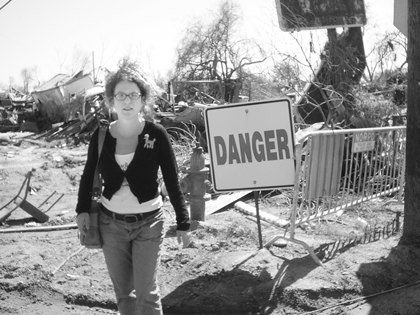By Andrei Codrescu
Andrea Garland was in Crawford, Tex., demonstrating against the war in Iraq when the Storm came. As news of the catastrophe engulfing her hometown reached her, she drafted some Vietnam vets who were willing to come to New Orleans to help. The vets were protesting the new war along Cindy Sheehan, the mother of a soldier who died in Iraq. Vietnam had been a lesson that America was quickly forgetting, and now here was an American city being abandoned by the U.S. government in its darkest hour. The war had come home.
It had happened before. In 1968, at the height of the war in Vietnam, American cities had exploded with rage.
The New Orleans floods of 2006 were a different situation, but the breached levees that had propelled the water into the city were related in some yet-to-be-understood way to the fires that engulfed America in the late ’60s.
Andrea reached a New Orleans occupied by several armies of the U.S., many of them National Guardsmen who had just come from Iraq. She helped organize rescue parties and gathered supplies to take to people still stranded in the city. She aided the escape of her friend Daniel, who had stayed behind with his two cats, unwilling to sacrifice his pets. Official rescue vehicles took out people, but not their pets. Many people refused, like Daniel, to part with their animals. They would rather die, and many people did. People drowned in the flood and countless pets perished. People also committed suicide, a story still not told in all its dark complexity.
When Andrea finally reached her neighborhood in New Orleans, at the edge of the Ninth Ward, she found her house damaged, but not as brutally ruined as some other houses on the street. Her husband, Jeffrey, her brother-in-law and some of her friends from Crawford, set to work immediately to clean what they could and to stop the invasion of mold that was visibly and literally eating up the old homes around.
She and Jeffrey also set out to re-establish their art gallery, L’ART NOIR, with a powerful show of “Toxic Art,” an exhibition by local artists using some of the toxic debris that covered the city. The centerpiece of the exhibition rose on the neutral ground in front of their house, including a collection of crosses that had also stood in Crawford, Tex., to symbolize soldiers killed in Iraq. The same crosses now stood on the border between the neighborhoods of Bywater and the Ninth Ward to symbolize the dead of New Orleans. In a single swift artwork, the victims of George Bush’s mismanaged war merged with the victims of George Bush’s bumbling internal policy. The dead of Iraq and the drowned of New Orleans testified together to the incompetence of our leaders.
Andrea Garland is an artist, Web designer, political activist and one of those people, like myself, who were adopted by New Orleans and given the space to create in what was the last urban bohemia in the U.S. I say was, but Andrea makes me think that it may be wrong to use the past tense. The Catastrophe brought all her different aspects together, while making her a true citizen, in the old sense of the word, an active member of the community. Let’s keep an eye on where Andrea goes from here because it may be the only sane direction.
Codrescu’s new book is “New Orleans, Mon Amour: 20 Years of Writings From the City” (Algonquin).






































